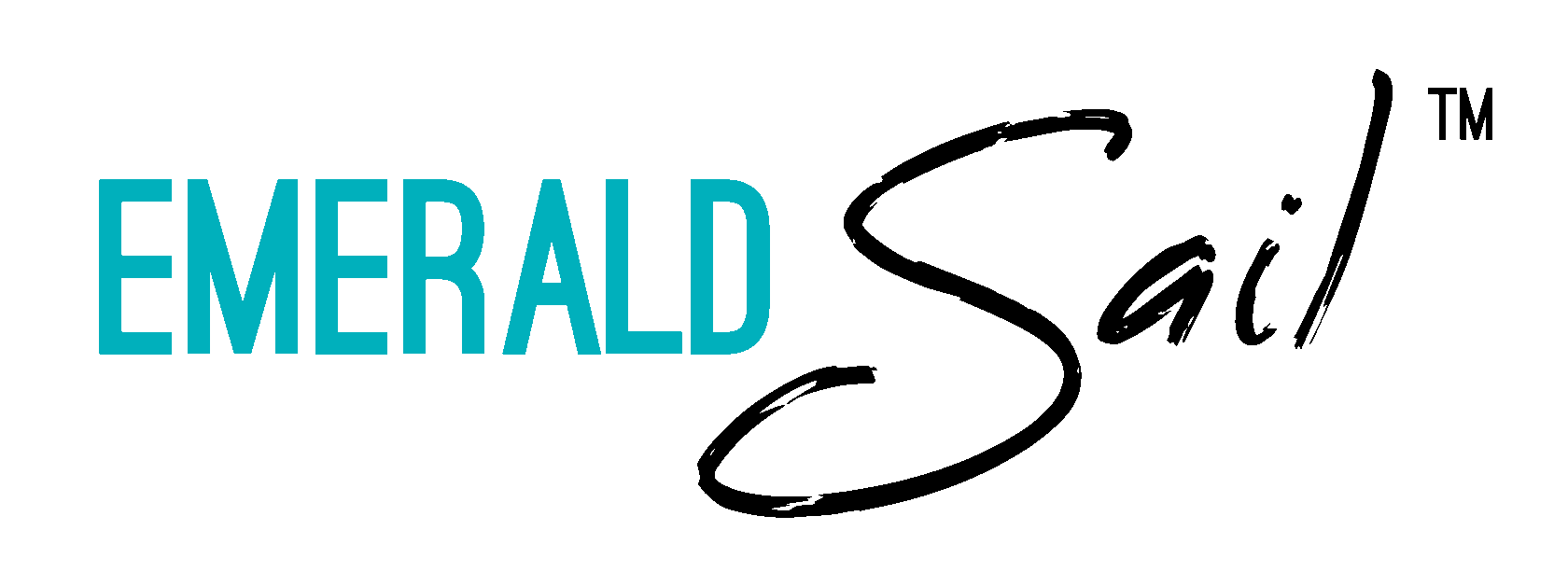Effective Date: March 09, 2023
At Emerald Sail, we are committed to protecting your privacy. This Privacy Policy outlines how we collect, use, disclose, and safeguard your information when you visit our website emeraldsail.com and engage with our services.
1. Information We Collect
We may collect personal information from you in various ways, including but not limited to:
• Contact Information: Name, email address and phone number.
• Usage Data: Information about how you use our website and services.
• Cookies and Tracking Technologies: We use cookies and similar technologies to enhance your experience on our site.
2. How We Use Your Information
Emerald Sail uses the information we collect for various purposes, including:
• To provide and maintain our services.
• To communicate with you, including sending you marketing communications via email and SMS messages.
• To respond to your inquiries and support needs.
• To improve our website and services.
• To comply with legal obligations.
3. Email and SMS Marketing
By providing your email address and/or phone number, you consent to receive marketing communications from us, including promotional emails and SMS messages. You can opt-out of these communications at any time by following the unsubscribe instructions included in each email or by replying "STOP" to any SMS message.
4. Sharing Your Information
We do not sell or rent your personal information to third parties. However, we may share your information in the following circumstances:
• With service providers who assist us in operating our website and conducting our business.
• When required by law or in response to legal requests.
• In connection with a merger, sale, or acquisition of all or a portion of our business.
5. Data Security
We take reasonable measures to protect your personal information from unauthorized access, use, or disclosure. However, no method of transmission over the internet or method of electronic storage is 100% secure. Therefore, we cannot guarantee its absolute security.
6. Your Rights
Depending on your location, you may have certain rights regarding your personal information, including:
• The right to access your personal data.
• The right to request correction of inaccurate data.
• The right to request deletion of your personal data.
• The right to withdraw consent for marketing communications.
To exercise these rights, please contact us using the information provided below.
7. Changes to This Privacy Policy
We may update this Privacy Policy from time to time. We will notify you of any changes by posting the new Privacy Policy on our website with a new effective date. We encourage you to review this Privacy Policy periodically for any changes.
8. Contact Us
If you have any questions about this Privacy Policy or our data practices, please contact us at:
Emerald Sail LLC
7901 4th St N, Saint Petersburg, FL 33702
info@emeraldsail.com
+1 (727) 335-SAIL (7245)
US Virgin Islands sailing guide
US Virgin Islands sailing vacations are among the top choices for sailors and vacationers every year—and for good reason, too. Comprising St. Thomas, St. Croix, St. James, and Water Island, the U.S. Virgin Islands (USVI) are coveted for their powdery, white beaches and stunning coral reefs across an impressive 117 miles of coastline.
With seven national parks, USVI is a haven of beautiful wildlife, which you can explore during your virgin island sailing charters by snorkeling and diving with the islands’ turtles and rays. Or you can head inland and explore the forests of the islands’ hilly terrain.
At night, you’ll want to head to Charlotte Amalie, the capital of St. Thomas, where the views of the many ships and boats along the night’s horizon are yet another one of USVI’s spectaculars.
USVI has a typical tropical climate, with year-round warm temperatures, ranging between 75F (23.89 C) and 82F (27.87 C), and the Caribbean’s characteristic rainy and dry seasons.
The rainy season is from May to November, with the highest rainfall from September to November.
The best time for USVI sailing is from December to April, during the islands’ dry season when there’s bright sunshine, low humidity, and light to moderate winds coming from the east. These conditions make for great sailing, cruising, and swimming, which is why a St. Thomas charter is a favorite for the holiday season.
The most popular time for travelers to book their St. John USVI sailing charters or St. Thomas charters is around the New Year. Other peak times for USVI sailing charters are in February and March, around Easter time, and during the Thanksgiving and Christmas holidays.

Start your USVI sailing trip from Compass Point Marina in St. Thomas by flying into the island’s airport: Cyril E. King airport.
You’ll find many non-stop flights to USVI from the U.S. mainland (incl. Miami, Fort Lauderdale, Atlanta); for most other flights, connections are made in San Juan, Puerto Rico. Popular airlines that fly to USVI include American Airlines, Continental Airlines, Delta Airlines, United Airlines, and US Airways. You’ll find that USVI’s ferry services have regular, timely schedules and inexpensive fees. Transfer time from Cyril E. King airport to the base is about 25 minutes by car.
Because USVI is a U.S. territory, entry requirements do not require a passport if you are a U.S. citizen. It’s worth noting, however, that you will need to provide evidence of citizenship when departing the islands (e.g., a raised-seal birth certificate and government-issued photo ID), so many travelers find it easier to simply bring their passports.
If you are not a U.S. citizen, a passport issued from your country of origin will be required for entry to USVI. As mentioned, USVI is a U.S. territory, so the currency used is USD. When USVI sailing, there are many marinas on St. Thomas and St. Croix, though it’s important to note that St. John doesn’t have any marinas. As an alternative, you can find anchorage sites and moorings on all islands for your USVI sailing charters.
In an effort to protect the islands’ marine wildlife and coral reefs from potential damage, the National Park Service has set up 210 moorings in National Park Waters around St. John; the Reef Ecology Foundation of St. Thomas and St. John has set up 45. While these moorings are free for public use, they are not meant to be used at night, so you’ll want to check out the restrictions beforehand to see if there are any fees.
The anchorages that are most popular for overnight stays are Caneel Bay, Francis Bay, and Maho Bay. Keep in mind that anchoring is permitted for up to 14 days in a 12-month period. But if you just can’t get enough of USVI sailing, you can apply for a long-term permit to anchor in a designated area for a one-month period.
As for provisioning, a great option is Pueblo Supermarkets, which has been serving USVI for over 50 years with two stores in St. Thomas and two in St. Croix.
Day 1. Yacht Haven Grande Marina (St. Thomas) → Christmas Cove
Just off the eastern coast of St. Thomas sits Christmas Cove, a sheltered oasis on Great St. James Island. Sea turtles, starfish, stingrays, and other magnificent marine animals live abundantly in the surrounding waters. That, combined with the ocean clarity make for the most spectacular snorkeling experience.
Day 2. Christmas Cove → Caneel Bay (St.John)
Located in the Virgin Islands National Park, Caneel Bay is a sandy crescent-shaped beach offering a relaxing ambiance with upmarket amenities. It is one of the first beaches you come to as you drive up North Shore Road out of St. John’s main port, Cruz Bay.

Day 3. Caneel Bay → Trunk Bay (St.John)
Home to some of the bluest waters in the Caribbean, Trunk Bay is the crown jewel of the Virgin Islands National Park. Trunk Bay is a photogenic paradise that even features 650 feet of underwater trails with signs for the most remarkable swimming and snorkeling experiences. This heart-shaped bay is arguably one of the most beautiful beaches in the world.
Within a protective cove, you will find Maho Bay. With long seagrass, Maho Bay is great for seeing turtles whilst snorkeling. North of Maho Bay and less popular (however just as beautiful) is Francis Bay. If you are looking for a more laid-back atmosphere Francis Bay is the perfect spot with turquoise blue waters and the breathtaking mountainous backdrop of St John.
Cinnamon Bay Beach is ranked as one of the most beautiful, pristine beaches within the Virgin Islands National Park. Enjoy 1/2 mile long of white sand dotted with stunning coconut palm trees, and plenty of cays to explore for snorkellers. You may even spot a turtle or stingray, as well as colorful fish.
Day 4. Trunk Bay → Leinster Bay (St.John)
Snorkeling in the USVI is fairly exceptional overall, but rocky windswept Leinster Bay is the #1 snorkeling spot in St. John. TripAdvisor even named this area, in conjunction with Waterlemon Cay, the #1 St. John attraction for travelers because there's a little something for everybody.
Day 5. Leinster Bay → Coral Bay (St.John)
Enjoy sunbathing or sightseeing on your way to Lameshure Bay. Make a lunch stop in Coral Bay which is a naturally protected bay on the east end of St. John which is made up of smaller bays such as Princess Bay, Hansen Bay, and Coral Harbor which features Lime Out, a floating Taco Bar! From Coral Bay, it’s an easy sail to the beautiful and family-friendly salt pond. Enjoy tropical sightseeing & convenient access to several trails right from the beach! The water here is fairly shallow, and the snorkeling is some of the best that the island has to offer, or continue over to Lameshure Bay. Lameshur Bay is located on the south shore of St John. It's a must-see spot due to its remote location, white sandy beach, and fantastic hiking trails with access to sugar mill ruins.
The snorkeling is some of the best in St John so make sure you try this out - you may even spot some octopus, rays, barracuda, tangs, parrot fish, Caribbean lobsters, coral banded shrimp, and Queen Angelfish.
Day 6. Coral Bay → Magens Bay (St.Thomas)
Located on the north shore of St Thomas, Magens Bay is about one mile long. As this beach is one of the most popular in St Thomas, it does get busy so the best times to visit are morning and late afternoon if you want to avoid the crowds.
If you would like a break from the beach, you can hike a nature trail. Amongst the mangrove trees, you may spot exotic birds and flowers.
Day 7. Magens Bay → Druif Bay → Yacht Haven Grande Marina (St. Thomas)
Enjoy snorkeling with turtles, relaxing on the beach, or grabbing some drinks and food at Dinghys beach bar. Golf carts are also available for rent to drive around the island. Be sure to explore the historic fort and enjoy the scenic view.
